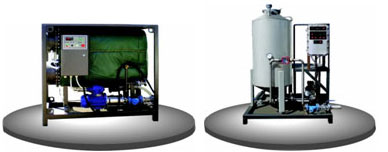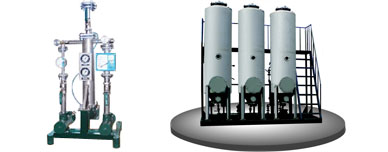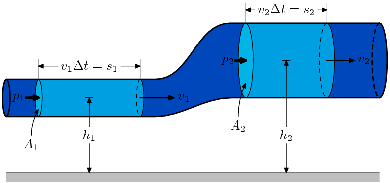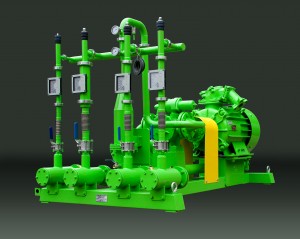Biodiesel Process
The process of biodiesel production is based on the reaction of transesterification of vegetable oil (triglycerides oil) with methyl alcohol to obtain methyl ester (biodiesel) and glycerin according to the following formula:

The transformation of vegetable oils, in order to be turned into fatty acid methyl ester or biodiesel, is carried out through the following continuous process: The quality of the entries in the Oil plant is key to the production, that is why upon the arrival of oil, the laboratory collects samples using a standardized system, and after their analysis it is determined whether it is necessary to be refined or degummed or it is appropriate for being used directly in the process.
In the process of refining and degumming, the oil first goes through some heaters which raise its temperature up to about 65 °C, which is the normal process temperature.
From heaters the oil goes to the mixing tanks where two additives are added, one at the beginning and another after thirty minutes. The additives used are commercial. The dose of additives depends on the volume of oil, as well as its rate of acidity. This part of the process takes about an hour. Then, the oil goes to the decanters where the gravimetric separation of the gums takes place. These gums are collected in a tank for subsequent sale or collection by an authorized manager. Finally, once the oil has been degummed, it is filtered to remove any remains. So, the oil would be ready to go on either to the process of biodiesel production or to be stored, according to the needs of the moment./p>
The refined oil goes through some heaters to reach the optimum reaction temperature , and then through a continuous reactor where, as it enters, it is mixed with the reagent prepared beforehand, a KOH solution in methanol. In this first reactor a 90% of the conversion is reached by transesterification reaction. In order to complete the reaction, the biodiesel is made to go through a second mixer.

These reactors work as hydrodynamic mixers and thanks to the cavitation phenomenon, the optimal conditions for the reaction to take place are reached. The biodiesel is decanted in order to separate the glycerol, which will be later stored in the tanks provided for this purpose. In the next stage, biodiesel goes to a methanol recuperator, where the methanol surplus, which after condensation can be re-used in the process, is recovered through distillation.

Finally, biodiesel goes to the purification area with a commercial resin and filtration. Eventually, high quality biodiesel is stored in tanks for shipment.
The basic principles of our technology
Our technology involves the Bernulli principle, which is a case of the general energy preservation law for a flow of an ideal uncompressible liquid (no internal friction):

pv2/2 + ?gH + P = const
Where:
p - density of the liquid
v - velocity of the flow
H - height of the liquid
P - pressure.
The constant on the right side of the equation is called the full pressure. The dimension of all of the equation components is a unit of energy per unit of liquid volume. This is called the Bernulli equation.
For a horizontal tube, H = const, and the equation will look look this: pv2/2 + P = const
According to Bernulli principle, full pressure in a stabilized flow of liquid remains constant along this flow. Full pressure consists of static pressure, dynamic pressure and weight pressure. The Bernulli principle implies that in the case of decrease of the flow’s cross-section, as the velocity (dynamic pressure) of the flow increases, which in turn, decreases static pressure. The Bernulli principle is also true for laminar flows of gases. The phenomenon of decrease of static pressure with increase of velocity of the flow is the principle of operation of various types of pumps and flow meters.
The Bernulli principle works ideally only for zero-viscosity liquids, i.e. liquids that do not have friction with and do not stick to the pipe surface. In reality, experiments show that velocity of a liquid on the surface of a solid body always precisely equals zero. This is the reason that various surfaces, subjected to flows of liquids, always have some kind of residue; this would also explain the layer of dust on a ventilator.
The Bernulli principle can be applied to a flow of an ideal uncompressible liquid through a small opening in a side wall or in the bottom of a wide vessel. According to the Bernulli principle:
pgh + P0 = pv2/2 + P0
where:
P0 – atmospheric pressure;
H – the height of the liquid in the vessel;
v – outflowing fluid velocity.
Hence v = (2gh)^0.5. This is the Toricelli formula. It shows that the liquid flows from an opening in a wide vessel at the same velocity as a free falling object.
BIODIESEL Blending System 18/3
BIODIESEL Blending System 18/3 is designed to blend up to three separate liquid components, at the rate of 4700 gallons per hour, particularly low-octane gasoline with additives, to prepare multicomponent motor fuel blends. These can include biodiesel blends. Ultimate blending system. The system can be used for oil-refining, food and chemical industry blending applications as well. It is designed to be operated indoors as well as in sheltered outdoor conditions.

Modern hydrodynamic stream fuel blending plants have proven themselves in industrial operations as an economic, accurate and steady solution for high-quality motor fuel blend production with optimal prime cost. In comparison with existing technology of fuel blending in blending vessels, the economy and increase of production profit margin can result in return on investment of 60 % a year. The project can break even in less than one year.HYDRODYNAMIC BLENDER
Liquid blending process occurs in the hydraulic blender. This process involves supplying of all components simultaneously according to the recipe. Finished product is delivered to storage tanks. The advantages of such blending technology are easy and accurate component dosage control, substantial reduction of fuel blending process time, no need of batching tanks for finished product homogenization. In the course of the fuel blending process in the stream mixer the consumption of each component is continuously controlled to provide finished product with steady quality parameters, according to the blending recipe. The fuel blend, obtained from the stream mixer, is homogenic and its component composition is in exact match with the recipe.
Aplications
Straight 100% biodiesel is almost never used as a motor fuel, instead, it is blended with regular petrol diesel in a certain proportion. Most commonly, blends like B2 to B20 are used. Therefore, biodiesel blending is an essential part of the biodiesel production industry, a growing sector of the energy and fuel industry.
USB system is an ideal solution for biodiesel blending, as well as bioethanol blending applications. The composite fuel produced with this fuel blending system remains stable for long periods of time, due to the highly intensive blending process. The liquids in the blender interact on a molecular level, which results in a stable and homogeneous mix. USB blenders make the process of blending ASTM compliant biodiesel to superior biofuel a lot simpler and a lot more efficient.
Other Advantanges
- Increase of biodiesel blending and composite fuel blending operations capacity
- Efficient and optimal usage of equipment
- Fuel blending process automation
- Drastic reduction of the impact the input material change has on the finished produc
- Significant reduction of transportation delays for shipments of the finished product
- Control of the finished product levels in tanks maximizes tank efficiency
- Easy planning of fuel blending operations
- Reduction of labor costs.
